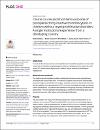Clinical course and short-term outcome of postsplenectomy reactive thrombocytosis in children without myeloproliferative disorders: A single institutional experience from a developing country.
| Author | Zvizdic, Zlatan |
| Author | Kovacevic, Aladin |
| Author | Milisic, Emir |
| Author | Jonuzi, Asmir |
| Author | Vranic, Semir |
| Available date | 2020-08-09T06:57:09Z |
| Publication Date | 2020-08-05 |
| Publication Name | PLoS ONE |
| Identifier | http://dx.doi.org/10.1371/journal.pone.0237016 |
| Citation | Zvizdic Z, Kovacevic A, Milisic E, Jonuzi A, Vranic S (2020) Clinical course and short-term outcome of postsplenectomy reactive thrombocytosis in children without myeloproliferative disorders: A single institutional experience from a developing country. PLoS ONE 15(8): e0237016. https://doi.org/10.1371/journal.pone.0237016 |
| Abstract | To evaluate the clinical outcome and complications in the pediatric population who had splenectomy at our institution, emphasizing the incidence of postplenectomy reactive thrombocytosis (RT) and its clinical significance in children without underlying hematological malignancies. The medical records of pediatric patients undergoing splenectomy were retrospectively reviewed for the period 1999-2018. The following variables were analyzed: Demographic parameters (age, sex), indications for surgery, operative procedures, preoperative and postoperative platelet count (postplenectomy RT), the use of anticoagulant therapy, and postoperative complications. The patients were divided into two groups according to indications for splenectomy: The non-neoplastic hematology group and the non-hematology group (splenectomy for trauma or other spleen non-hematological pathology). Fifty-two pediatric (37 male and 15 female) patients who underwent splenectomy at our institution were reviewed. Thirty-four patients (65%) were in the non-hematological group (splenic rupture, cysts, and abscess) and 18 patients (35%) in the non-neoplastic hematological group (hereditary spherocytosis and immune thrombocytopenia). The two groups did not differ significantly in regards to the patients' age, sex, and preoperative platelet count (P>0.05 for all variables). Forty-nine patients (94.2%) developed postplenectomy RT. The percentages of mild, moderate and extreme thrombocytosis were 48.9%, 30.7%, and 20.4%, respectively. The comparisons of RT patients between the non-neoplastic hematology and the non-hematology group revealed no significant differences in regards to the patients' age, sex, preoperative and postoperative platelet counts, preoperative and postoperative leukocyte counts, and the average length of hospital stay (P>0.05 for all variables). None of the patients from the cohort was affected by any thrombotic or hemorrhagic complications. We confirm that RT is a very common event following splenectomy, but in this study it was not associated with clinically evident thrombotic or hemorrhagic complications in children undergoing splenectomy for trauma, structural lesions or non-neoplastic hematological disorders. |
| Language | en |
| Publisher | Public Library of Science |
| Subject | thrombocytosis splenectomy pediatric population |
| Type | Article |
| Issue Number | 15 |
| Volume Number | 8 |
| ESSN | 1932-6203 |
Files in this item
This item appears in the following Collection(s)
-
Medicine Research [1904 items ]


